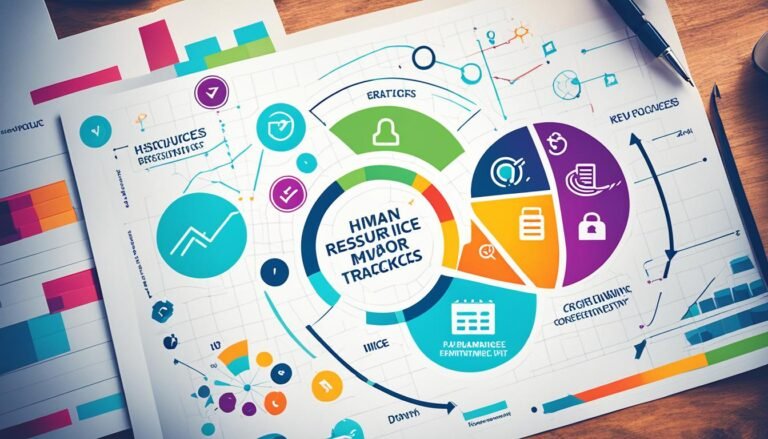A Guide to HR Employee Training Techniques
Employee training and development are crucial for companies looking to enhance their workforce’s skills and improve overall performance. By implementing effective training methods and strategies, organizations can empower their employees to contribute to organizational objectives and increase productivity. Additionally, training programs should be flexible and personalized to adapt to the changing nature of markets. Investing in employee training not only boosts employee satisfaction but also improves compliance with standards, promotes innovation, and enhances the company’s corporate image.
Key Takeaways:
- Employee training and development play a vital role in improving organizational performance.
- Training programs should be tailored to current and future roles within the company.
- Effective training methods ensure the development of employees’ skills and increase productivity.
- Continuous and personalized training is essential to match the evolving market demands.
- Investing in employee training yields benefits such as increased employee satisfaction and improved corporate image.
The Importance of Employee Training and Development
Employee training and development are crucial aspects of a company’s organizational culture. They play a vital role in keeping employees up-to-date with rapidly evolving markets and inspiring them to excel in their roles. Training not only fulfills personnel needs but also serves as the foundation for building a robust internal training program within the company. Additionally, the presence of well-structured career plans and internal promotion programs provides employees with a clear pathway for professional growth, instilling a sense of value and motivation.
Investing in employee training and development yields numerous benefits. Firstly, it enhances employee satisfaction, as individuals feel supported and valued by their organization. Secondly, it leads to increased productivity levels, as employees gain new skills and knowledge that enable them to perform their jobs more effectively. Furthermore, training incentives such as workshops, seminars, and educational opportunities foster a culture of continuous learning, ensuring that employees remain engaged and motivated to develop their skills.
Establishing well-defined career plans is equally vital for employee training and development. Career plans provide employees with a clear vision of their professional journey within the company, outlining the skills they need to acquire and the milestones they need to reach. This clarity enables employees to set goals and work towards achieving them, facilitating a sense of purpose and direction in their careers.
By investing in employee training and development and implementing comprehensive career plans, organizations create an environment that promotes employee growth, satisfaction, and longevity in the workplace. This not only benefits individual employees but also contributes to the overall success of the company.
The Benefits of Providing Employee Training
Offering employee training programs brings substantial benefits to both employees and companies. It increases employee satisfaction and motivation, provides a personalized analysis of current skills and areas for improvement, ensures equal opportunities for learning, prepares employees for new responsibilities, and shows employees that they are valued.
From a company perspective, employee training improves productivity, compliance with standards, and innovation. It also reduces turnover and enhances the corporate image, making the company more appealing to potential candidates.
| Benefits for Employees | Benefits for Companies |
|---|---|
|
|
Investing in employee training not only benefits individuals but also creates a positive impact on the overall success of the company. By providing opportunities for growth and development, companies can foster a culture of continuous learning and improve employee satisfaction, ultimately leading to a more productive and engaged workforce.
QUOTE
“Investing in employee training is investing in the growth and success of your company.” – Richard Branson
The Main Goals of Company Training
When it comes to company training, it is crucial to have clear goals in mind. By setting specific objectives, HR departments can align training programs with the needs of the organization and ensure that employees have the necessary skills and abilities to contribute effectively to the company’s success. The main goals of company training include:
1. Individual Suitability
Ensuring that individuals are suitable for their positions
Each employee should have the right skills and knowledge to perform their roles effectively. Through targeted training, companies can identify individual training needs and provide the necessary support to enhance employee capabilities.
2. Hitting Targets
Helping employees reach their targets
By providing training that focuses on specific objectives and performance targets, companies can empower employees to achieve their goals. This not only enhances productivity but also boosts employee motivation and job satisfaction.
3. Attracting and Retaining Talent
Attracting and retaining talent
Investing in employee training programs demonstrates a commitment to professional development and growth opportunities. This can attract top talent to the organization and increase employee loyalty, reducing turnover rates.
4. Promoting a Mindset of Change
Promoting a mindset of change within the organization
In today’s fast-paced business environment, companies need to embrace change and foster a culture of innovation. Training programs that focus on developing adaptability and embracing new ideas can help employees embrace change and drive continuous improvement.
By prioritizing these goals, companies can ensure that their training initiatives contribute to individual and organizational success. With targeted and effective training, organizations can have a skilled and motivated workforce, ready to navigate the challenges of a dynamic marketplace.
Types of Employee Training
When it comes to employee training, there are various methods that organizations can utilize to develop their workforce. These methods include eLearning, on-the-job training, instructor-led learning, and role playing.
eLearning: In the post-pandemic world, eLearning has gained significant popularity. It provides employees with the flexibility to learn at their own pace and access training materials remotely. This method is particularly useful for individuals who prefer self-directed learning and want to fit training into their busy schedules.
On-the-job training: On-the-job training allows employees to learn while they work, making it a highly effective method for acquiring practical skills. This type of training offers hands-on experience and immediate feedback, helping employees develop job-specific competencies and adapt quickly to their roles.
Instructor-led learning: Instructor-led learning involves direct interaction between trainers and employees. This type of training often takes place in a classroom or workshop setting where trainers deliver content, provide guidance, and facilitate discussions. Instructor-led learning allows for real-time clarification of concepts and encourages active participation.
Role playing: Role playing is a highly engaging form of training that helps employees practice real-life scenarios. By assuming different roles and simulating workplace situations, employees can enhance their problem-solving skills, teamwork abilities, and communication techniques. Role playing promotes a dynamic learning experience and prepares employees to handle challenging situations effectively.
By incorporating a mix of these training methods, organizations can create a comprehensive and well-rounded employee development program. Each method offers unique benefits and caters to different learning preferences, ensuring that employees receive the necessary training to excel in their roles.
Additional Types of Employee Training
Aside from the traditional methods of employee training, there are various other techniques that organizations can incorporate to enhance the skills and knowledge of their workforce. These additional types of training can provide unique opportunities for professional development and contribute to overall employee growth. Let’s explore some of them:
Coaching
Coaching involves pairing employees with experienced professionals who can offer guidance and support on specific tasks and responsibilities. This one-on-one approach allows individuals to receive personalized attention and targeted feedback, enabling them to develop their skills effectively.
Simulation Training
Simulation training provides employees with a chance to practice tasks and scenarios in a safe, controlled environment. By replicating real-life situations, employees can gain hands-on experience without the fear of making mistakes. This type of training is especially beneficial for roles that require quick thinking and problem-solving skills.
Collaborative Training
Collaborative training fosters a learning environment where employees can learn from and teach each other. By encouraging collaboration and knowledge-sharing among team members, organizations can leverage the collective expertise and experiences within their workforce to enhance overall performance and innovation.
Video Training
Video training offers easily accessible resources that employees can utilize to gain knowledge and acquire new skills. With video tutorials, demos, and webinars, employees have the flexibility to learn at their own pace and revisit the material whenever necessary. This type of training is particularly beneficial for remote or geographically dispersed teams.
Cross-Training
Cross-training involves providing employees with opportunities to learn tasks and responsibilities outside of their primary roles. By encouraging employees to gain knowledge and experience in different job functions, organizations can foster versatility, improve collaboration, and create a more well-rounded workforce.
These additional types of employee training can complement traditional training methods and offer a more diverse and holistic approach to professional development. By incorporating a variety of training techniques, organizations can tailor their training programs to meet the specific needs of their employees and empower them to thrive in their respective roles.
The Rise of Microlearning and Blended Learning
In the rapidly evolving landscape of employee training, two trends have gained significant traction: microlearning and blended learning. These innovative approaches have revolutionized the way organizations approach training and development, offering a more effective and engaging learning experience for employees.
Microlearning: Bite-sized Learning for Maximum Impact
Microlearning involves delivering small, focused bursts of information or learning material to employees. These bite-sized learning modules are designed to be easily consumed by employees, allowing them to acquire knowledge and skills in a short period. By breaking down complex topics into manageable chunks, microlearning enables employees to learn at their own pace, reinforcing knowledge retention and improving overall training outcomes.
With the increasing use of mobile devices, microlearning has become even more accessible and convenient, as employees can access training materials anytime, anywhere. This flexibility has made microlearning a popular choice for organizations looking to provide just-in-time training and ongoing reinforcement of key concepts.
Microlearning is particularly effective when it comes to reinforcing specific skills or addressing knowledge gaps. It helps employees quickly acquire new information or refresh their existing knowledge, making it an ideal approach for just-in-time training needs.
Blended Learning: A Holistic Approach to Training
Blended learning combines different training methods and formats to create a well-rounded and comprehensive learning experience. It integrates traditional instructor-led training with digital learning tools, such as eLearning modules and online resources.
This hybrid approach allows organizations to leverage the benefits of both face-to-face and online training, providing a flexible and personalized learning experience for employees. By combining the strengths of different training methods, blended learning caters to a diverse range of learning styles and preferences, ensuring maximum engagement and knowledge retention.
Blended learning also allows for greater customization and personalization of training programs. Organizations can tailor the learning journey to meet the specific needs and goals of individual employees, ensuring a more relevant and impactful training experience.
Spaced Learning, Gamification, and Mobile Learning
In addition to microlearning and blended learning, several other trends have emerged in the field of employee training. Spaced learning, also known as distributed learning, involves delivering learning content in spaced intervals over time. This approach has been found to enhance long-term memory retention and knowledge application.
Gamification is another exciting trend that applies game elements and mechanics to training programs. By introducing elements such as challenges, rewards, and leaderboards, gamification enhances engagement, motivation, and knowledge retention among employees.
Mobile learning, as mentioned earlier, has become increasingly popular due to the ubiquity of smartphones and tablets. It allows employees to access training materials and resources on their mobile devices, enabling learning on the go and facilitating continuous learning.
The rise of microlearning, blended learning, spaced learning, gamification, and mobile learning marks a significant shift in the way employee training is approached. Organizations that embrace these trends stand to benefit from increased knowledge retention, improved engagement, and a more skilled and adaptable workforce.
In Summary
Microlearning and blended learning have become prominent forces in the realm of employee training. The bite-sized nature of microlearning enables employees to acquire knowledge and skills quickly, while blended learning combines various training methods to create a comprehensive learning experience. The incorporation of spaced learning, gamification, and mobile learning further enhances training effectiveness and engagement. By embracing these trends, organizations can ensure their training programs are not only impactful but also tailored to the evolving needs of their workforce.
Evaluating and Measuring Training Programs
Effective training programs require evaluation and measurement to ensure their success. By assessing the effectiveness and impact of these programs, organizations can make data-driven decisions to enhance their training initiatives. Two crucial components in evaluating training programs are training program evaluation and learning management systems (LMS).
Training Program Evaluation
Training program evaluations provide valuable insights into the effectiveness of training initiatives and their impact on employees and organizational performance. These evaluations involve systematic assessments to determine whether the intended learning outcomes have been achieved.
“Training program evaluations provide valuable insights into the effectiveness of training initiatives and their impact on employees and organizational performance.”
During training program evaluations, various methods can be utilized, such as surveys, interviews, observations, and performance assessments. These evaluations help identify strengths and areas for improvement, enabling organizations to tailor their training programs to better meet the needs of their employees.
Learning Management Systems (LMS)
A learning management system (LMS) is a digital platform that provides organizations with tools and features to manage, deliver, and track training programs. These systems offer data and analytics that enable HR departments to monitor employee progress, measure training success, and calculate the return on investment (ROI) of their training initiatives.
Key features of an LMS include:
- Centralized training content management
- Online course delivery
- Assessment and quiz functionalities
- Progress tracking and reporting
- Integration with other HR systems
With the help of an LMS, HR departments can easily track employee engagement, completion rates, knowledge retention, and performance improvement.
Here is an example of a basic table representing employee training evaluation metrics:
| Evaluation Metric | Description |
|---|---|
| Training Completion Rate | The percentage of employees who successfully complete the training program |
| Knowledge Retention | Assessing the level of knowledge retained by employees after completing the training |
| Performance Improvement | Measuring the impact of training on employee performance in their roles |
| Employee Satisfaction | Gauging the satisfaction levels of employees regarding the training program |
| Return on Investment (ROI) | Evaluating the financial benefits gained from the training program compared to the costs incurred |
By continuously evaluating and measuring training programs, organizations can identify areas for improvement, optimize their training approaches, and ensure that training initiatives align with strategic goals.
Integrating Employee Training with Career Development
Integrating employee training with career development initiatives is crucial for ensuring employee growth and retention. By aligning training programs with employees’ long-term career goals, companies can create a supportive environment that fosters professional development and enhances job satisfaction.
Mentorship programs play a vital role in guiding and supporting employees throughout their careers. When experienced professionals provide mentorship, employees gain valuable insights, advice, and encouragement to overcome challenges and make informed career decisions. Mentorship programs can be formal or informal, depending on the company’s structure and needs.
Continued learning opportunities are essential for employees to stay updated with industry trends and acquire new skills. Lunch-and-learn sessions, workshops, and online video training are effective methods of providing ongoing learning experiences in a convenient and accessible manner. This enables employees to expand their knowledge base, enhance their expertise, and remain competitive in the evolving job market.
Employee feedback plays a crucial role in customizing training approaches and addressing specific learning needs. By regularly seeking input from employees about their training experiences, companies can identify areas for improvement, refine training methods, and enhance the overall effectiveness of the training programs. Employee feedback creates a culture of open communication and empowers employees to contribute to their own development.
By integrating employee training with career development initiatives, organizations demonstrate their commitment to nurturing talent, supporting employee growth, and providing a clear path for advancement. This not only benefits individual employees but also contributes to the overall success and competitiveness of the company.
Conclusion
HR Employee Training Techniques are crucial for enhancing the skills and performance of employees. By implementing effective training methods, companies can not only improve employee satisfaction, productivity, and innovation but also align training programs with the organization’s goals and integrate them with career development initiatives.
Continuous evaluation, feedback, and customization are key factors in delivering successful training programs. By investing in employee training, companies can foster a culture of continuous learning and development, leading to a more skilled and motivated workforce. It is through such professional development initiatives that companies can stay competitive and adapt to the dynamic business landscape.
Employee development strategies that encompass a variety of effective training methods, such as eLearning, on-the-job training, and role-playing, can cater to the diverse learning needs of employees. The rise of microlearning and blended learning has further revolutionized the way companies approach employee training, making it more engaging and accessible.
In conclusion, HR Employee Training Techniques are vital for empowering employees and driving organizational success. By prioritizing employee development and implementing a range of effective training methods, companies can create a learning culture where employees thrive, ultimately reaping the benefits of improved performance, increased satisfaction, and enhanced corporate image.







